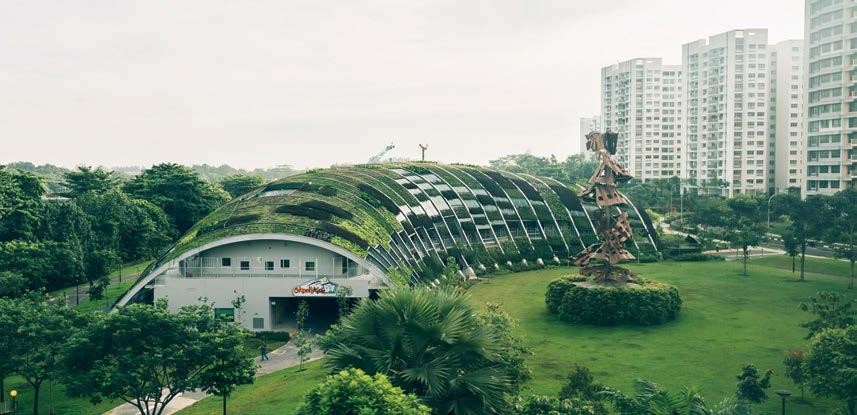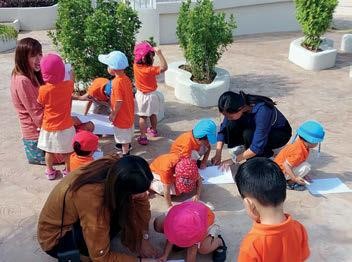Would you enrol your little one in a large childcare centre that can hold up to 1,000 kids? EVELINE GAN reports on this hot trend in estates with high demand.


My First Skool
Finding and securing a childcare spot for your little one can be a frustrating, hair-tearing affair.
But with large childcare centres sprouting up in the heartlands over the last few years, parents can look forward to more affordable and quality preschool programmes.
Since 2016, these megasized centres, some of which can take up to 1,000 kids, have opened in estates with more young families. This is part of the Government’s efforts to ensure that every parent who needs a preschool place for their little one will be able to have one. Here, we find out more about this new preschool experience.

School4Kidz
What are large childcare centres and how are they different from regular-sized preschools?
In a large childcare centre, your little one may have as many as 999 schoolmates attending school at the same time.
About three to five times the size of childcare centres that are located at HDB void decks, these larger centres can each accommodate anywhere between 300 and 1,000 children, according to the Early Childhood Development Agency’s (ECDA), the regulatory and developmental authority for the early childhood sector in Singapore.
“The larger space allows centres more scope to design stimulating learning environments, such as age-appropriate play areas, garden spaces, art and teacher resource rooms,” says ECDA’s spokesperson.
For example, My First Skool (MFS) at 2 Punggol Drive, which opened its doors in May, boasts five exciting outdoor playscapes across its sprawling 94,561 sq ft campus, including an outdoor playground as well as themed water, land, mountain and forest play zones.
Children enrolled at the Skool4Kidz campus at Sengkang Riverside Park, which also started operations this year, enjoy ample opportunities for outdoor learning, thanks to its location nestled amid the lush greenery of the surrounding park.
It features facilities that regular-sized preschools do not have due to limited space, such as an indoor garden atrium with sky bridge, a butterfly lodge, an atelier loft and reading space, a unique dining space that will serve food from garden harvests, as well as themed outdoor play corridors.
Where are they located?
Large childcare centres are located in areas of high preschool demands, such as estates with many young families.
Young Parents’ checks revealed that nine of these jumbo-sized childcare centres have opened in Sengkang, Punggol, Yishun, Woodlands, Jurong West and Bukit Panjang. Together, they have created 5,000 preschool places.
Another five new ones are slated to open in Sengkang and Punggol by 2020, according to ECDA. Details for registration for the five new large childcare centres will be announced in the first half of next year.
How is the quality of childcare and education kept consistent in such a large preschool setting?
While the campus size is larger, the quality of care and education remains a key priority, as in all preschools and childcare centres here, says ECDA’s spokesperson.
Similar to a regular-sized preschool, large centres offer a comprehensive series of programmes that are designed to cater to the development needs of young children from two months to six years of age, says Teri Teo, director of communications and capability development at School4Kidz.
These large childcare centres are also run by anchor operators, which are appointed by ECDA. Each centre is subjected to the same regulations that the agency has for smaller centres, such as teacher-to-children ratios ranging from one educarer to five infants 18 months old and younger, to one teacher to 25 children in Kindergarten 2, Teri explains.

School4Kidz
With so many kids on campus, will my little one get easily distracted?
Built for greater access to nature and more opportunities for outdoor learning, many of the newer large childcare centres feature open spaces and shared communal facilities.
But would this, as well as having so many other chatty preschoolers in the same space, inadvertently end up distracting your little one from learning well?
Educators say it won’t. For one, teachers provide materials and activities that occupy the children and engage them throughout the day, which prevents them from becoming completely distracted, says Ainul Farhana Mohd, one of the two executive principals at MFS at 2 Punggol Drive.
That campus also uses a high-tech visual paging system to broadcast and alert teachers when parents or caregivers arrive to pick their children, thus minimising classroom disruptions during evening pickups.
On the other hand, some “distractions” that occur when classes transit for toilet breaks, outdoor activities and group dining may encourage children to focus better, Ainul shares.
“In today’s society, we are required to work in an environment full of distractions – your phone will ring, your colleague will walk to your desk,” Ainul says.
“Children, too, need to learn to work and be engaged in an environment with some kind of distraction so as to learn to better adjust their focus when it comes to learning. The ability to focus and re-focus amidst distractions is something that shouldn’t be ignored.”
What about noise control?
The schools have this covered with noise-minimising classroom designs and smart lessons scheduling strategies.
For instance, Skool4Kidz Campus minimises unnecessary noise with sound-absorbing materials such as ceiling boards, rubber flooring and solid doors.
Over at MFS at 2 Punggol Drive, classroom ceilings are incorporated with sound baffles, which reduce the level of airborne sound and contain noise levels to each learning area.
“We also schedule lessons and classroom activities at different times and areas so that not all the children are in the same area, at the same time. Also, teachers and children are encouraged to practise their ‘indoor’ voices when they are in the classrooms or indoor spaces,” Ainul says.

My First Skool
What happens if there is a disease outbreak or an emergency in school?
Similar to typical preschools, large childcare centres adhere to ECDA’s regulatory requirements and have contingency plans in place in case of outbreaks and other emergencies.
“Although these centres typically enrol more children, the larger centres are appropriately developed to minimise spread of infections and provide a safe, child-friendly environment,” says Teri of School4Kidz.
For instance, every child is screened at the drop-off point before she is allowed into the centre. There are routine temperature and visual checks twice a day.
In an event of a disease outbreak, infection control guidelines by Ministry of Health kick in, such as informing and updating parents on the outbreak situation, following up with parents of infected children and liaising with the authorities, intensifying daily cleaning and disinfection of toys, materials and equipment used by the children.
What are the school fees like?
Under the Anchor Operator scheme, which provides funding to selected preschool operators, the schools are required to keep fees affordable.
According to ECDA’s website, full-day childcare fees are capped at $720 per month, full-day infant care at $1,275 per month and kindergarten fee at $160 per month (excluding GST) for Singapore citizens. Fees are before subsidies.
Playground or preschool?
Check out two new large childcare centres that have started operations this year.
SKOOL4KIDZ CAMPUS AT SENGKANG RIVERSIDE PARK
Getting upclose and personal with nature is an everyday reality for kids enrolled in Skool4Kidz Campus at Sengkang Riverside Park. The two-storey cocoon-like campus, which can accommodate 462 children and infants, is designed to provide a “park within a park” learning experience.
It features an indoor garden atrium with skybridge, a butterfly lodge, an atelier loft with reading space and a unique dining space that will serve food from the school’s garden harvests.
There are also outdoor play corridors that extend learning outside the classrooms seamlessly. These innovative play areas provide for multiple open-ended play and learning spaces, where your little one gets to explore and discover water and sand, as well as other natural and recyclable materials such as wood and pebbles.
The preschool uses technology in its curriculum to support and enhance learning experiences. For instance, mobile devices and tablets are used in the surrounding gardens for kids to access interactive educational content when they venture outdoors.
VISIT www.skool4kidz.com.sg


MY FIRST SKOOL EARLY YEARS CENTRE AT 2 PUNGGOL DRIVE
You’d be forgiven for thinking that the My First Skool (MFS) campus at 2 Punggol Drive is a mega playground instead of a preschool.
Featuring five unique play areas – an outdoor playground, water play zone, land play zone, mountain play zone and forest play zone – this sprawling 94,561 sq ft-large Early Years Centre is every kid’s wonderland.
It is designed to take up to 1,000 children from aged two months to four years. Early Years Centres tie up with nearby Ministry of Education Kindergartens, which provide early childhood services for children aged five to six.
The five unique playscapes, all located outdoors, encourage learning through sensory play, as well as build up children’s confidence, social and motor skills.
For instance, child-friendly rock-climbing mounds and stepping logs at the mountain play zone allow kids to hone their strength, flexibility and motor skills, while the gardening activities available at the land play zone encourage them to appreciate the value of responsibility when they grow their own plants, from seed to harvest.
The centre’s indoor learning areas, designed to let in plenty of natural light, are equally exciting.
They are segregated into different zones – creative, expression and relaxing – to allow kids creative expression and ample chance for exploration. The school also boasts communal dining spaces where children aged 18 months to four years dine together and socialise.
VISIT www.myfirstskool.com

























